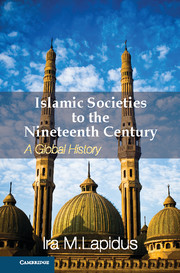Book contents
- Frontmatter
- Contents
- List of Illustrations
- List of Figures
- List of Maps
- List of Tables
- Preface
- Acknowledgments
- Acknowledgments to the first edition of A History of Islamic Societies
- Acknowledgments to the second edition of A History of Islamic Societies
- Publisher's Preface
- Introduction to Islamic Societies
- Part I The Beginnings of Islamic Civilizations
- The Middle East from c. 600 TO c. 1000
- The Preaching of Islam
- The Arab-Muslim Imperium (632–945)
- Chapter 5 Introduction to the Arab-Muslim Empires
- Chapter 6 The Arab-Muslim Conquests and the Socioeconomic Bases of Empire
- Chapter 7 Regional Developments: Economic and Social Change
- Chapter 8 The Caliphate to 750
- Chapter 9 The ʿAbbasid Empire
- Chapter 10 Decline and Fall of the ʿAbbasid Empire
- Cosmopolitan Islam: The Islam of The Imperial Elite
- Urban Islam: The Islam of Scholars and Holy Men
- Women, Families, and Communities
- Part II From Islamic Community to Islamic Society
- Part III The Global Expansion of Islam from the Seventh to the Nineteenth Centuries
- Glossary
- Bibliography
- Annotated Bibliography from A History of Islamic Societies, 2nd Edition
- Index
Chapter 9 - The ʿAbbasid Empire
Published online by Cambridge University Press: 05 February 2013
- Frontmatter
- Contents
- List of Illustrations
- List of Figures
- List of Maps
- List of Tables
- Preface
- Acknowledgments
- Acknowledgments to the first edition of A History of Islamic Societies
- Acknowledgments to the second edition of A History of Islamic Societies
- Publisher's Preface
- Introduction to Islamic Societies
- Part I The Beginnings of Islamic Civilizations
- The Middle East from c. 600 TO c. 1000
- The Preaching of Islam
- The Arab-Muslim Imperium (632–945)
- Chapter 5 Introduction to the Arab-Muslim Empires
- Chapter 6 The Arab-Muslim Conquests and the Socioeconomic Bases of Empire
- Chapter 7 Regional Developments: Economic and Social Change
- Chapter 8 The Caliphate to 750
- Chapter 9 The ʿAbbasid Empire
- Chapter 10 Decline and Fall of the ʿAbbasid Empire
- Cosmopolitan Islam: The Islam of The Imperial Elite
- Urban Islam: The Islam of Scholars and Holy Men
- Women, Families, and Communities
- Part II From Islamic Community to Islamic Society
- Part III The Global Expansion of Islam from the Seventh to the Nineteenth Centuries
- Glossary
- Bibliography
- Annotated Bibliography from A History of Islamic Societies, 2nd Edition
- Index
Summary
Baghdad
The first venture of the new regime was the creation of a new capital. From ancient times, Middle Eastern rulers had built new cities as headquarters for their armies and administrative staffs and as symbols of the advent of a new order. The rulers of the Assyrian Empire created the famous cities of Nineveh and Nimrud; the Sasanians founded Ctesiphon. In a strategic location on the main routes between Iraq, Iran, and Syria – in one of the most fertile parts of Iraq with ready access to the Tigris-Euphrates water system – the ʿAbbasids built Baghdad to be their palace and administrative base. (See Map 3.)
Like its predecessors, Baghdad rapidly transcended the intentions of its founders and grew from a military and administrative center into a major city. The very decision to build the administrative center – called the City of Peace (Madinat al-Salam) – generated two large settlements in the vicinity. One was the extensive camp of the ʿAbbasid army in the districts to the north of the palace complex (al-Harbiya), and the other, to the south (al-Karkh), was inhabited by thousands of construction workers brought from Iraq, Syria, Egypt, and Iran. Here were markets to provision the workers and their families and workshops to produce their clothes, as well as utensils, tools, and factories to supply the building materials for the construction project. The original Baghdad, then, was a three-part complex – the troop settlement in al-Harbiya, the working populations in al-Karkh, and the administrative city itself, Madinat al-Salam. No sooner was the City of Peace completed than the decisions of the caliphs to build additional palace residences and administrative complexes in the immediate vicinity stimulated the growth of additional quarters. Across the Tigris, the new palace district of al-Rusafa also promoted urban development.
- Type
- Chapter
- Information
- Islamic Societies to the Nineteenth CenturyA Global History, pp. 91 - 104Publisher: Cambridge University PressPrint publication year: 2012



